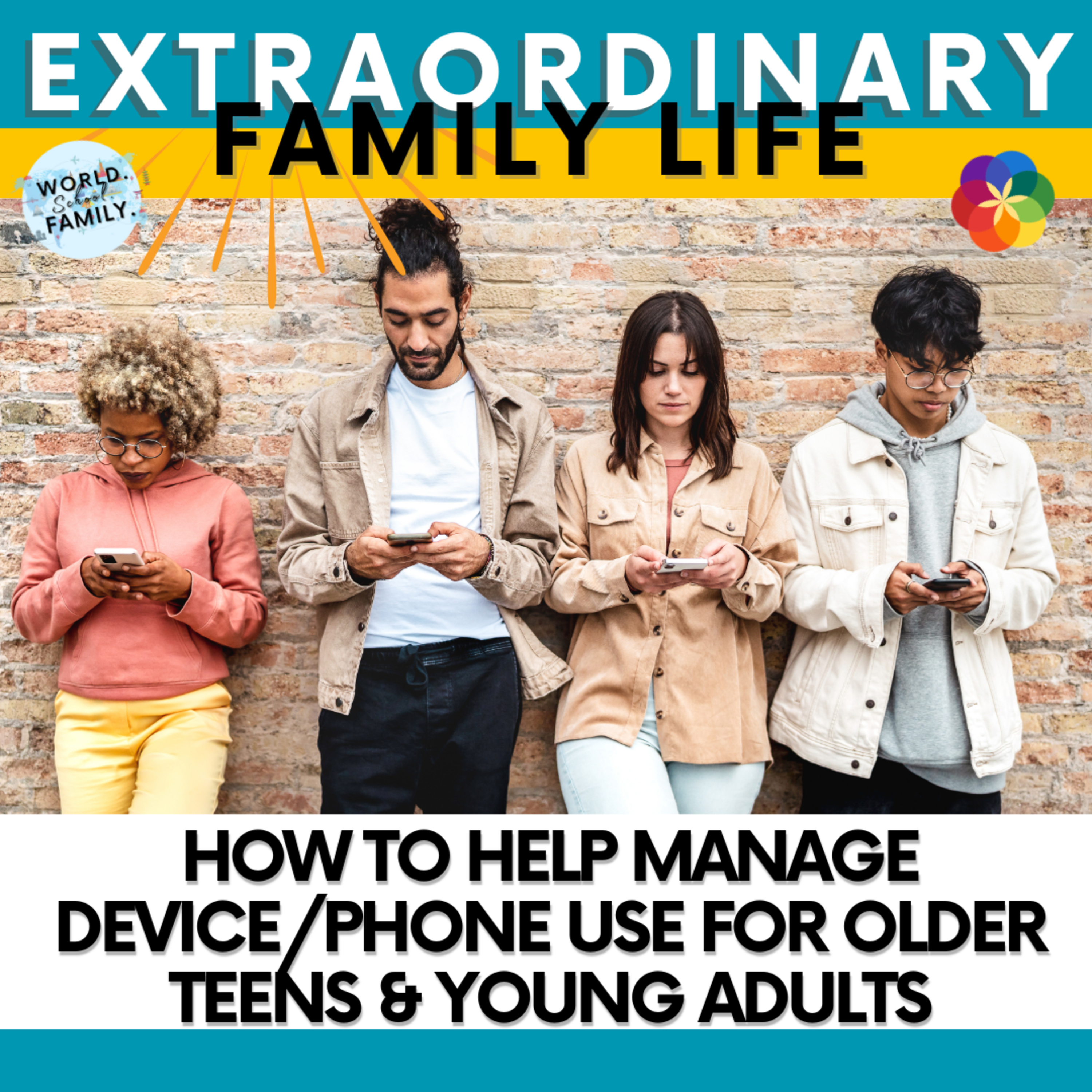How to Help Your Teen Find Balance with Technology

In today’s hyper-connected world, healthy tech use is one of the biggest parenting challenges we face. Devices are everywhere — in their hands, their pockets, beside their beds. And while screens offer powerful tools for learning and connection, they can also slowly erode our teens’ confidence, focus, and emotional well-being — if we’re not intentional. This post expands on the ideas we shared in our podcast episode, #287 How to Help Manage Device/Phone Use for Older Teens & Young Adults, offering practical, real-world strategies to help your teen build a better relationship with technology — one that allows them to thrive both online and offline.
Why Healthy Tech Use Matters More Than Ever
We’re not trying to raise kids who live in caves or never use a smartphone.
Technology isn’t the enemy.
But when tech use becomes mindless or addictive — when it starts replacing conversations, creative thinking, or the ability to just be alone with one’s thoughts — it becomes a problem.
Healthy tech use means using technology intentionally — not constantly.
It means choosing when and how to engage with screens instead of being pulled along by them all day long.
It’s the key to helping our teens reclaim their time, attention, and peace of mind.
The Hidden Costs of Always Being Connected
The research is clear: constant digital input affects everything from attention spans and emotional regulation to sleep and self-esteem.
Teens who are always connected to social media are more anxious, more distracted, and more likely to compare themselves to others — which makes it harder for them to develop a strong sense of identity.
Tech use isn’t just about apps and screens.
It’s about the way they think, how they connect, and who they are becoming.
What Offline Time Gives Back
We want our teens to develop grit, creativity, and connection — and that only happens when they spend time away from screens.
When teens engage in real-world activities — reading, playing music, building things, volunteering, spending time outdoors — they gain confidence and emotional intelligence.
They learn to communicate face-to-face, build friendships, and discover who they are without a filter or a feed.
Simple, Powerful Ways to Build Better Tech Habits
These strategies aren’t about punishing your teen or “taking away” everything they love.
They’re about helping them self-regulate — so they can enjoy the benefits of tech without being controlled by it.
1. Create a Family Tech Agreement
Involve your teen in creating a family contract that outlines when and how devices are used. Empower them to have a voice in the rules — and make it a conversation, not a lecture.
2. Establish Tech-Free Zones
Make the dinner table and bedrooms screen-free. These small shifts create huge ripple effects in connection and focus.
3. Encourage Mindful Use
Help your teen become aware of how they use technology. Are they actively learning or mindlessly scrolling? Are they energized or drained after use?
4. Model the Habits You Want Them to Have
Your example matters. If they see you checking your phone at every red light or during meals, they’ll mirror that behavior. Show them what balance looks like.
5. Make Room for Offline Passions
Give them time and space to try new things. Hobbies like drawing, hiking, writing, or fixing things with their hands build real-world skills and self-worth.
Rediscovering Connection — With Nature, Family, and Self
Healthy tech habits aren’t just about less screen time.
They’re about more real life.
More laughter at the dinner table.
More hikes.
More meaningful conversations.
More boredom — the kind that leads to creativity and growth.
And more connection to who they really are.
The Real Goal: A Lifelong Skill
Learning to manage technology isn’t a one-time fix.
It’s a skill your teen will use for the rest of their life — in college, in relationships, at work.
Helping them build that skill now is one of the greatest gifts you can give.
Final Thoughts
The goal isn’t to eliminate tech.
It’s to use it on purpose.
When your teen learns to live with intention — to engage with screens when it serves them and unplug when it doesn’t — they gain ownership of their life.
This doesn’t happen overnight.
But with consistency, communication, and connection, it does happen.
To dive deeper into this topic and hear practical advice on creating healthy tech boundaries for older teens, listen to episode #287 of the Extraordinary Family Life Podcast. We share what’s worked for our own teens, and what we’ve learned (sometimes the hard way) as a tech-using, world-traveling family with seven kids.
RESOURCES:
Let us help you in your extraordinary family life journey.
- JOIN GREG'S 90-DAY HEALTH & FITNESS CHALLENGE!
- Get Rachel's Family Systems & Charts
- Join the 28-Day Challenge for Moms
- Rachel’s Must-Read Booklist for Well-Read Moms
- Greg's Recommended Reading List for Parents & Youth
- Join the Be The Man Coaching and Tribe
- Download the Be The Man app on iOS or Android
- Take the Be The Man 7-Day Challenge.
- Follow us on Instagram: @worldschoolfamily or @greg.denning
- Gather with us at the World School Family (Beach & Farm) Resort in Portugal
- Read our reviews here: https://podcast.extraordinaryfamilylife.com/reviews/
--- Send in a voice message: https://podcasters.spotify.com/pod/show/extraordinary-family-life/message












